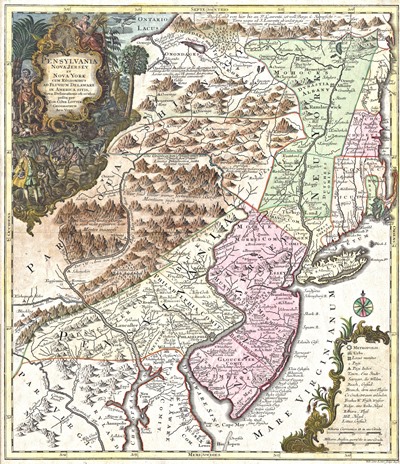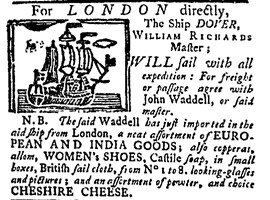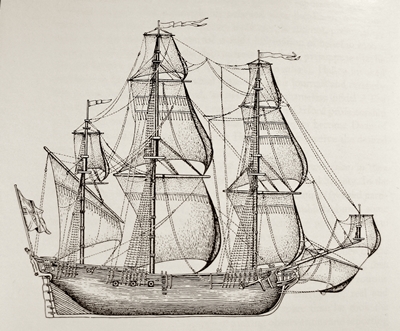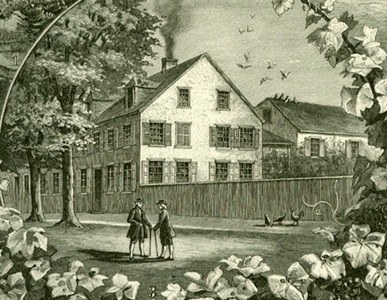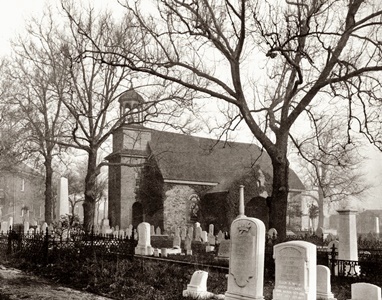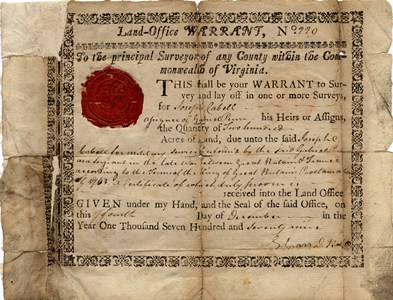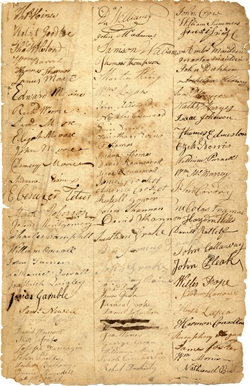The Pioneer
Anthony Andrew Bushong
Part 2: Andrew's Return
Maryland to Kentucky
By Rick Bushong, 2013
Integrated with Nicholas' article: April 15, 2018
|
The America Andrew returned to. In this 1756 map of Pennsylvania, New Jersey, New York, also most of Delaware.
(Published 1756.)
|
1754 - A Return - But to Delaware
|
|
"For London directly, The Ship Dover, William Richards, Master; Will Sail with all expedition: For freight or passage agree with John Wadell or said master." Jan 7, 1754, New York Mercury.
|
|
Probably towards the end of August, 1754, a ship sailed out of Cowes, in England and began the voyage to America. The voyage, originated in Rotterdam and the ship was the Recovery, commanded by Ship's Master, Amos Jones. On that ship Andrew and the the other passengers consisted of Protestant (and one Catholic) Palatines. Interestingly among the voyagers was Johann Nicolaus Buschi, (listed as Nicholas Buskey). Nicolaus' family genealogy intertwines with the Boschung family all the way back to Boltigen, Switzerland. Because of that he was believed to be possiblet a third cousin to Andrew, however DNA evidence, has shown he was adopted into the Buschi line.Read more here and here. The Buschi family also had moved to Tippstadt, Germany, and to America, Nicolaus Buschi brought his wife, Anna Catharina (Schmalenberger) Buschi and two young sons, Christian Daniel and Johann Henrich. When the voyage began, Daniel was less than three and Henrich was not yet a year old. Other details of the voyage are scant, possibly because of their ultimate destination, but when the ship cast off. there were at least 82 male passengers over the age of 16, and probably some 100 to 125 women and children. During the eight plus week voyage, at least one baby was born. On September 6, 1754, John Philip Jacob Helphenstine joined the immigrants, somewhere in the middle of the Atlantic Ocean. His father, Peter Helphenstine is listed with the other immigrants.2
The Recovery reached the shores of America sometime in the third week of October, then headed up the Delaware River that leads to Philadelphia harbor. But inexplicably, Capt. Jones steered the boat off the Delaware, some 30 miles away from Philadelphia, and sailed up the Christina River to Wilmington, Delaware.
They dropped anchor in what was then, Wilmington's small port.2 This was the only time one of the ships carrying colonial immigrants is known to have done that.2; 3 For the Wilmington townspeople, it must have been a curious sight, to watch the ship's passengers, a mixture of Palatinate immigrants and returnee's as they rowed ashore from ship.
|
It was not Captain Jones' and the Ship Recovery's, first voyage to America, and in fact they had sailed to Philadelphia just the year prior.View clipping, But this was their only transatlantic crossing ever recorded with immigrants, and why he mysteriously chose to land in Delaware will probably never be known.2
But from his choice, two things become readily apparent; first, there was no ready market, as in
Philadelphia, to indenture, or in other words, "sell off" insolvent passengers.14 This fact leaves no alternative explanation, except that most, if not all the passengers had money for their passage and likely no one was indentured, including Andrew. But the second thing is, since Delaware, had not had a boat load of European immigrants land on its shores for decades. So they likely administered no Oath of Allegiance, and they would not be formerly taken to City Hall. The Wilmington townsfolk would not even be aware of any pending charges against Andrew or anyone else for that matter. This would be critical to Andrew since, to clear his name with Captain Diemer, he would have agreed to fight in the Pennsylvania Militia the next time they were needed. Or there is the off-chance, the desertion charges, had not been settled, and he would be arrested. Either way, if Andrew went to Philadelphia, he was a wanted man, for the prior charges or for the military. In that light, it is not so far-fetched, that Andrew would have sought out or arranged to sail specifically to Delaware, instead of Philadelphia. He was after all a seasoned voyager on his third transatlantic crossing so this remains an intriguing possibility.
Capt. Jones' Ship's Passenger List, contains the names of 82 male passengers, with no women or children listed. On the list, Andrew is noted as "Andreas Bushon ". This list is also an important piece of evidence and helps illustrate, this Andreas Bushon was returning, because his surname was already anglicized. He had probably not used the original spelling of "Boschung"
since 1732, when he was fifteen years old, on the Pink "John and William." So on the Recovery, identifying himself as Andreas Bushon.2 when he stepped onto the Delaware shore his fare was paid in full, the desertion charges were likely settled, and he would be under no legal restraints. As such, he was a freeman, as long as he stayed out of Pennsylvania.
|
|
A copy of the original 1754 passenger manifest from the Ship Recovery. Andreas Bushon is listed in the middle row, seventh from the top. |
But why would Andrew have left? It would have been sometime after the beginning of 1752 as Andrew sold property in December of 1751 (mentioned below). But for the Pennsylvania immigrant, Andrew to leave America in another transatlantic crossing, it must have been serious. Though implausible, maybe as mentioned above, the 1746 desertions charges were never settled and he perhaps he had to flee as a wanted man?
|
|
|
|
Still, ships usually checked passenger's papers, and would have spotted a deserter. Further, the British doctrine, "Nullum tempus occurrit regi" that means no lapse of time bars the King prevails in England to this day, and would rule out any kind of statute of limitations.4 But a more likely scenario still is with the looming threat of war, the militia was being increased. So it seems that Andrew left to avoid being pressed into service - again. To lend credence to this idea, as will be seen, Andrew did seem to stay out of Pennsylvania, even if it was just a few miles over the border in Delaware.5; 6; 7; 8; 9
But this does not explain how he could leave his wife and family. It is not known, but perhaps something happened to Maria and possibly some of his children too. Because, as his military record illustrates,Read Part 1 Andrew did not even want to go as far as 270 miles over-land from Cocalico, Pennsylvania to Albany, New York, in order to stay close to his family.10; 11; 12 So it seems likely Maria and two children had tragically died or were killed. This is an obvious conclusion because there is no further evidence for his wife or children, John Henry or Maria Julianna, after their baptisms. But perhaps more convincing is, this is why he later remarried and also why he reused the names "John" and "Henry" on his future sons.
|
Though at least one of Andrew's children lived, Andrew Jr., who with one parent surviving, would need no Guardianship papers. When Andrew left for Germany, the child was probably taken to one of his aunts, until Andrew's return. Also, since Andrew's father and mother had, as discussed, probably died in 1733, and his uncle Hans(John), the immigrant died in 1749, much of his family was gone and there was little keeping him from going back to the "Fatherland".13 But what a daunting undertaking to voyage to Europe and then back again to America.
Nevertheless, lots of colonial immigrants, did endure multiple crossings. In fact, they were coming and going quite regularly. Mittelberger does not say how many passenger were on his return voyage to Europe in 1754, but he frequently references them, and there were more than a few. Even Mittelberger's original plan was for three crossings, where he would return to Europe and retrieve his wife and children then bring them back to America,(even though he
later chose to stay in Europe).14 William Penn, himself, eventually crossed back and forth four times and he was a much older man.15 Others did too, Daniel Rupp's "30,000 Names" book has many listed who had more than just the one crossing. Like Friederich Post, who immigrated with Rev. Jacob Lischy, the Moravian minister whose church records, "Lischy's Private Pastoral Record" are so often quoted. They arrived May 28, 1742. on the Snow(ship)"Catharine", then Post
returned to Europe in 1749 and later came back to Pennsylvania.16 The clergy, too, seemed to travel back and forth quite a bit, Rev. Michael Schlatter, of St. Gall, Switzerland, had four crossings.16 But perhaps the best example, for this discussion, of colonist voyaging to Europe comes from John Brubaker, whom Andrew most likely knew...
|
|
Ships were leaving for England and Europe and like these two ads to, Ireland and the British Virgin Islands on a regular basis. Published Dec 10, 1753, the New York Gazetteor. |
John Brubaker (1719-1804), was a son of Hans John Brubaker and Anna Emst Brubaker and a good friend of Martin Meixel, who was Andrew's brother in-law by sister, Maria Julianna.17 It might also be recalled that John Brubaker, is related to the Bushong family as Sally
Strickler's great uncle. Sally is the wife of Jacob Bushong (1790-1873), whose farm, in Virginia, is where the New Market Battle occurred. Brubaker and Andrew were contemporaries, and likely friends, too. His story from the "Biographical annals of Lancaster County, Pennsylvania"(1903), illustrates one possible allure for Andrew to visit the Fatherland.18
"John Brubaker, the eldest son, after having grown to manhood desired to go to Switzerland(Germany)to seek a wife, but his parents were dissuaded from consenting. However, he went after his father's death, in the year 1750, arrived in his father's native land, and was received with great joy. His friends had two lamps burning evenings. He was successful in his matrimonial undertaking, and found a maiden, Maria Newcomer, who was willing to cast her lot with him in the New World. John Brubaker and Maria Newcomer entered into the sacred relation of matrimony A. D. 1750, eight days before Whitsuntide. They then sailed for America, it is not known how soon after their marriage, but presumably at their earliest convenience."18
|
The Germantown Home of Christian Sower II and Print Shop, where he printed Sower's Paper, among other things. In the Revolutionary War, Sower was wrongly accused of being a loyalist and had his home, print shop and all property confiscated. |
|
Checking the facts of the story, Brubaker's father, Hans John Brubaker died in 1748, and Brubaker actually returned to Philadelphia, Sept 9, 1749 on the Ship "St. Andrews".16 So the correct date John Brubaker and his new wife are married is shown to be eight days before Whitsunday, in 1749, which is Saturday, May 17, 1749.19 Brubaker had obviously sailed to Europe, shortly after his father's death. It seems quite reasonable to think, Brubaker, and his new bride would have spoken with Andrew about their trip. They may have even given him the inspiration to go.
And that is exactly what Andrew did. He sailed back to Europe, probably visiting his home in Schmalenberg, Germany. Following the envisioned loss of his family, Andrew visited his Homeland and was possibly looking for a wife. Whether or not he found one, we can not say, when he returned, the ship's manifest only listed the men over age 16 and did not list the women and children, let alone a wife. Perhaps she died on the voyage, but this seems unlikely since Andrew was a veteran voyager on his third crossing. Maybe he came back alone? Either way he returned on the "Recovery," to Wilmington Delaware, on October 23, 1754 and called himself Andreas Bushon.
|
How Did He Pay For Passage? |
"Dewalt Becker enlisted in the King's Army and took away the papers of his and Adam Wagner's land. Wagner bought the land from Andreas Bushung, in Derry Township,
Lancaster County. He serves warning against any purchase of the land from Becker."20 Sower's Paper, April 30, 1757
|
This advertisement in Sower's Paper, published April 30 1757, is important, because it verifies Andrew selling property, but that is not the whole story. How much was Andrew's land worth and how much did he sell it for?
| |
"The price of farms in Pennsylvania, especially round Philadelphia, is already quite high; from 30 to 50 florins are paid for an acre, only a day's journey from the city, although the ground is still uncleared forest land. If a place is desired for a homestead, which is already in a habitable and cultivated condition, containing a dwelling-house, barns and good stables, together with meadows, orchards, tilled fields and
sufficient woodland, twice as much is asked for it as for uncultivated land, the price being about one hundred florins per acre."14
|
|
The florin Mittelberger wrote of, could be any of several gold coins, used in Europe, similar to the "Florentine florin" first minted in 1252. They were a little smaller than a nickel with about 3.5 grams of gold.21 But Andrew, who had just obtained the properties in the middle of 1749, would not have had much time, by December, 1751, to improve the land, and obviously, the 100 miles distance from Derry to Philadelphia is more than a days ride from Philadelphia, so Mittelberger's price of 30 to 50 florins per uncleared acre, is probably a little high. But even if it were as low as 10 florins per acre it would be 570 florins, and it could have possibly sold for more. Andrew would have had a lot of money. So what did he do with it
all? He used it to travel, back to the Europe, and then return again in 1754, on the ship, Recovery. To put a price on the passage, we can use Mittelberger's 1750 - 1754 prices as he describes them.
| |
"A person over 10 years pays for the passage from Rotterdam to Philadelphia 10 pounds, or 60 florins. Children from 5 to 10 years pay half price, 5 pounds or 30 florins. All children under 5 years are free. For these prices the passengers are conveyed to Philadelphia, and, as long as they are at sea, provided with food, though with very poor, as has been shown above.14"
|
|
|
|
Gold florins were made by many countries, typically with a fleur-de-lis on one side. They were not a large coin, about 20 mm diameter, or a little smaller than a nickel containing, about 3.5 grams of gold.21
|
|
Knowing the price of passage, 60 florins, adds perspective on how much Andrew's property was worth and easily, he was a well to do land owner. So Andrew had sold some of his property, which definitely provided ample money for the voyages to Europe and back. But the 37 year old Andrew, with all his wealth, still was without a complete family. He needed a wife.
|
|
Andrew's marriage occurred in the Immanuel Church in New Castle, Delaware, where he and Catherine are assumed to have married. The church has been used continuously since 1706. The bell tower was added in 1820. Photo by Ph. B. Wallace
|
|
Over the next five years, war raged on between Britain, France, and the Indian Nations. The conflict was especially difficult in Pennsylvania, where Andrew, surely would have been pressed into service, so he was probably just trying to stay far away and went unnoticed. Then Tuesday November 6, 1759, in the New Castle Parish, New Castle County, Delaware, Andrew married again. Following a proclamation in the form of a Banns, "Aeneas Ross", a Missionary in the Immanuel Church, formalized the marriage of Anthony Bushong and a Cathrine, (maiden name unknown), of New Port.5 Then Rev. Ross recorded their marriage in the church book.5; View original-full page.
 Click to enlarge.
Click to enlarge.
The fact that Rev. Ross issued the banns with Andrew's seldom used first name, Anthony, is an important fact that ties him back to the Anthony Andrew Bushong of Lancaster. This and the fact that Andrew's descendants' DNA matches his uncle Hans Bushong's descendants, leaves no doubt that Lancaster County Andrew and this Andrew are one and the same.22; Read article
The Immanuel Church where they were married, is an old church. Construction began in 1703 and it was built in the shape of a cross, and called a "cruciform." It is the oldest church of English construction on the Delaware and services have been held there continuously since its completion in 1706. There is a memorial tablet on the wall that tells of the first rector, Rev. George Ross, who came as a missionary from England in 1703. The Ross family were very influential in Colonial America and the American Revolutionary War. After serving for fifty years, Rev. Ross retired and his son Aeneas took over. Rev. Aeneas Ross, 1716-1783, aside from issuing their banns and marrying Andrew Bushong to Catherine, is famous for his own daughter in-law. His son John Ross was a soldier and patriot in the war and his wife was Elizabeth Phoebe Griscom. Elizabeth always went by Betsy and she is better known as Betsy Ross, the creator of the first American flag. Read about it on Wikipedia. Aeneas' brother, George and his sister, Gertrude, both played a part in the founding of America too. Because both George Ross and Gertrude's husband, George Read, were signers of the Declaration of Independence.
|
For at least a year or so, following their marriage, Andrew and his new wife Catherine stayed in New Castle County, probably still in the New Port area. They began their family on Aug 17, 1760, when a son, John was born. He was later baptized in the church in Wilmington, a few miles away from New Castle. At the "Old Swedes Church", Rev. Andrew Borell's records show he baptized John, the son of "Andrew Busheon and Cathrina" on Dec 7, 1760. 7
The Old Swedes Church, also known as Holy Trinity Church, has the distinction of being the nation's oldest church that still stands as it was originally built.23 But within a year they had moved some 120 miles away, and on Dec 17, 1761, another son was born in Frederick County, Maryland to "Andreas Buschon and Catharina". He was baptized there, April 25, 1762 in the Evangelical Reformed Church.8; 9 It is not certain what the name for this child was. It could be son, Valentine, but most
researchers have settled on their son, Jacob, since he fought along side his brother, John, in the Lincoln County, Kentucky Militia, during the Revolutionary War.24
|
|
The Old Swedes Church, where son, John Bushong was baptized, was built in 1698 and is the oldest original church in the United States. Photograph taken in the 1920s.
|

|
|
Looking for new opportunities, sometime before 1766, Andrew crossed from Maryland into Augusta County, Virginia. Inevitably traveling down the Shenandoah Valley, he ultimately settled on a plot of land on a creek known as Cub Run and acquired a land warrant for it.25 The Cub Run is described as a left hand branch of the Shenandoah River. Andrew had his 120 acre property surveyed November 10, 1770, and they noted it was adjoining a Robert William's property.26 When Andrew moved to the Cub Run area, he came not only with his family, but also likely his brother, Henry, who acquired his land sometime between 1766 and 1774. It was also on Cub Run (adjoining a John Carpenter's 110 acres).25; 26
While living in Virginia Andrew and Catherine had at least two more sons and possibly a third. George Bushong, who was born in 1767 or early 1768, somewhere along the Cub Run, and Henry, born Jun 19, 1771, surely born there too.26; 27; 28 The third could be Valentine and he has been established through later Ohio land transactions with his mother. But his date and place of birth as well as death has yet to be found.31 In 1778, Andrew's property along Cub Run and considerable other land was split off of Augusta County, to form the new Rockingham County.
|
It should be mentioned, son George is traditionally said to have the middle name of Washington, and it is so listed on his newer tombstone, but it is unlikely that in 1767, Andrew would have named him after then Lieutenant Colonel George Washington. The middle name was probably taken or added sometime after the Revolutionary War or possibly added when his later tombstone was carved.
When Henry was born in 1771, Andrew was 54 years old. It is important to note, that by naming a son John in 1760 and Henry, in 1771 it is further evidence that Andrew's first son, "John Henry" had died. Later in 1781, for Augusta County, the tax officers made a Tithable's List (tax list), but neither Andrew or his brother are listed. This suggests that they had sold their Virginia land and had moved, which is probably the case because next, Andrew is found in Tennessee.25; 29; 30
|
|
An example of a Virginia Land Warrant. To the principal Surveyor of any County within the Commonwealth of Virginia. This shall be your warrant to Survey and lay off in one or more Surveys, for ________ his Heirs or Assigns, The Quantity of ____ Acres of Land, due unto the said Andrew could have had a warrant similar to this, but without military service, possibly as an assignee as Gabriel Penn was in this one.
|

The actual Cumberland Compact, May 1780, by Richard Henderson. (enlarges a little) |
|
The 120 acres in Virginia was inevitably fine property, but Andrew obviously was not completely ready to settle down. It seems after some fourteen years in Virginia, there were still some trails he had not traveled. So perhaps sensing an opportunity for more land, he was enticed into new territories again, this time to the west. Because in 1780, while the Revolutionary War raged on, he is found in Nashville, where he had settled in the quasi-state of Transylvania. In May of that year, Andrew was a signer of the Cumberland Compact.29 There is a possibility that it was Andrew's son, Andrew Jr., who was in Tennessee, but since he is found in Virginia afterwards and reportedly made his "mark" on papers, instead of a signature, it is doubtful.32 The compact was a forerunner of the Tennessee State Constitution and the signatures were gathered during May of 1780. It was written by Richard Henderson, an entrepreneur from North Carolina. The compact was signed by residents and settlers, virtually all of whom had bought property from Henderson's Transylvania Land Company.33 From this, it can be concluded that Andrew had sold his Virginia acreage and had become a Tennessee landowner having moved his family to the area surrounding Nashville.
Henderson's Transylvania Land Company began in 1775, when he purchased most of the territory from the chiefs in the Cherokee tribe. Even though just two years later, the purchase was declared illegal, Henderson's company had eventually attracted hundreds of settlers to Tennessee. Most of them were encouraged by plentiful land and the efforts of Henderson's employee, the well known trail-blazer, Daniel Boone. Just that year, Boone had completed carving the trail through the Cumberland Gap and virtually all of Transylvania's pioneering settlers, mainly from Virginia, followed Boone's path.34 The Nashville area was roughly divided up by stations, also called forts, that could provide some security from the Indians. Andrew and his family would have lived nearby one of them.
|
Nashville Area Stations around 178035
- Nashborough (Nashville)
- Gasper Mansker's, in Summer County
- Bledsoe's, near Castalian Springs
- Asher's, on Station Camp Creek near Gallatin
- Stone's River, west on the Hermitage at Clover Bottom
- Freeland's, one mile northwest of Nashville
- Eaton's, on the east side of the Cumberland, two or three miles below Nashville
- Fort Union, about six miles up the Cumberland from Nashville.
|
In May of 1780, when Andrew and the other 250 pioneers, signed the compact, they were a rugged bunch. Among their numbers were Andrew and James Crockett cousins of Davy Crockett, and both legends in their own right.36 The Crockett brothers, who also ended up in Kentucky, not only mined and smelted their own ore, but they were master gunsmiths. They were well known manufacturers of the Kentucky Long Rifle, that was used by so many pioneers.36 The weaponry was needed because, this was truly the frontier, and it was still filled with dangers, especially from the Indians, who were constantly a threat. Most often, it was the Shawnee tribe being incited by the British, who provided weapons, and other times they were dissatisfied with the Cherokee's sale of lands they shared. Either way the danger was always present. Just between the years of 1776 and 1782, in confrontations with the Shawnee, Daniel Boone's daughter was captured, and a son was killed. Another time, he was shot in the ankle, captured and held prisoner for five months.34 Between the years 1776 and 1790, it is estimated, some 1,500 settlers were killed by the Indians.37
|
|
Andrew's signature (left column, 3rd from bottom), on the Cumberland Compact in May of 1780.
|
|
|
|
A 1795 Kentucky Map, showing Fayette County and Lexington. |
|
Still, in these dangerous and untamed territories, Andrew had apparently not gotten over his wanderlust. Possibly because of the increased Indian hostility, causing some Nashville areas and stations to be abandoned or maybe just looking for one last opportunity for land, Andrew left Tennessee. He is next found having moved some 200 miles away, with property in the Lexington area of Fayette County, Kentucky. There has been no records discovered for this, but it is implied by the 1790 Fayette County land tax records, in which his wife, Catherine, is listed as the Widow Bushong.38 It is likely, shortly after signing the Cumberland Compact, Andrew sold, lost, or gave up his Tennessee land, because within a year, April 1781, his sons John and Jacob are in Kentucky and presumably Andrew had gone with them. But he did not join the Lincoln County, Kentucky Militia, like John and Jacob, who in April, were Privates under the command of Brigadier General George Rogers Clark.24
Moving into Kentucky, Andrew had to use Boone's Wilderness Trail. It was just a few years old, and much of it was barely wide enough for foot traffic. Yet here was Andrew, now at least 63 years old, traveling through wild country on new and barely passable trails. And he was still keeping up with the likes of Daniel Boone, who was 17 years younger and the Crockett brothers, both more than 20 years younger. But at this age the trek was likely to have been his last big adventure. Andrew Bushong lived, possibly in the southern Lexington area, for a few more years, until around 1790, when he died. He would have been about 73 years old. However as yet there has been no will, records, or tombstones found, but with his widow and sons living close by, it is surely the case.
|
In 1797, Catherine moved to Ross County, Ohio, with her sons, John and Valentine. She would live there for another 20 years, inevitably as the much loved Family Matriarch. Catherine Bushong died probably in Chillicothe, where she owned property, some 27 years after Andrew, in about 1817. This is determined from the sale of some of her estate also in Chillicothe.39 We do not know the date of Catherine's birth, but she was obviously a younger second wife to have lived so long after Andrew. So to establish a time period, if she was about 20 when she had her son John, she would have been born about 1740. That makes her around 77 in 1817. In the sale of Catherine's Chillicothe property, there are four heirs and their spouses noted, John and Jannet Bushong, Jacob and Jane Bushong, George and Martha Bushong and Henry and Isabella.39 Not named are Valentine who might have died and Andrew Jr. who also might have died, yet could have been her stepson.
|
|
|
However, the legacy of Johann Nicholas Bushong's son, the palish colour, German Swiss immigrant and American pioneer, Andrew Bushong, has lived on. This man would not fight for a King, but inevitably fought to build a life for himself and his family in Pennsylvania and the untamed American frontiers of Virginia, Tennessee, and Kentucky. In doing so he helped to build a country, his way. Yet he had many descendants including at least two sons, who fought
for their country, only it was against the British Monarchy, in the American Revolutionary War. Then two sons, as well as a grandson or two, again fought, against the Crown, in the War of 1812.27; 40 During the American Civil War, many of his great and great great grandsons fought, including 19 who carried the Bushong surname. Of those, all but a couple fought for the Union and five of them paid the ultimate price.41 His descendants also served their country in America's other wars, and some gave their lives, dying in countries like, Luxemburg and France as well as places like the Gulf of Leyte, in the Pacific Ocean. Today there are thousands of known descendants, who can all trace their lineage back to one man, Anthony Andrew Bushong.41 They too have helped to build the United States of America in thousands of different ways, a few of which are noted here...
|
Highway Patrol, Ranchers, Carpenters, Drummer, Race car Drivers, Judge, Metallurgist, Pharmacy Technician, Small Engine Technicians, Slow Pitch Hall of Fame Member, Deputy Sheriff, Boil Makers, Locomotive Boiler Maker, Author, Teachers, Coach, Bus Driver, Truck Drivers, Farmers, Railroaders, Machine Operators, Chef, Blast Hole Driller, Plumbers, Oil Field Driller, Photographers, Artists, Actor, Astrologer, Mailmen, Dentist, Doctors, Miners, Coal Miners, Chair Maker, Cabinet Makers, Entrepreneurs, Businessmen, Poultry man, Hunting and Fishing Guide, Bank Executive....
This Article is Copyright ©2013, 2016, 2023 by Rick Bushong and Commercial Use is Prohibited.
Non-commercial use is allowed with permission or only if entire copyright is included.
To continue reading, The Frontiersman and the Lady -
John Bushong and Jenette Young click here
or Return to Part 1

References: Part 2 - Anthony Andrew Bushong, the Return.
- Wikipedia: French and Indian War
- Pennsylvanian German Pioneers, A Publication of the Original Lists of Arrivals In the Port of Philadelphia
From 1727 to 1808, By Ralph Beaver Strassburger, LL.D., President of the 'Pennsylvania German Society, Edited by
William John Hinke, PH.D., D.D, In Three Volumes, Volume I. 1727 - 1775, Published 1934, pages 559 and 660 http://babel.hathitrust.org/cgi/pt?id=inu.30000007109121;view=1up;seq=748
- The Flow and the Composition of German Immigration to Philadelphia, 1727-1775 By: Marianne Wokeck Source: The Pennsylvania Magazine of History and Biography, Vol. 105, No. 3 (Jul., 1981), pages 249-278 http://www.jstor.org/stable/20091588
- Law-dictionary explaining the rise, progress and present state of the British Law
By Thomas Edlyne Tomlins
-
Anthony Bushong and Catherine of New Port, Banns issued 1759: Sketch of Early Ecclesiastical Affairs in New Castle, Delaware, and History of Immanuel Church by Thomas Holcomb, Delaware Printing Company. Published 1890, page 221. Read full PDF on Bushong United
- New Castle County, Delaware Marriages, 1649 -1899 FHL Film Number 0006414 to 0006422:
http://genealogytrails.com/del/newcastle/newcastlemarriages-B.html
- Son John is born: "Delaware Births and Christenings, 1710-1896" John Busheon, son of Andrew Busheon and Cathrina. Born Sep 17 1760, christening Dec 7 1760. at Old Swedes Church, Wilmington, New Castle, Delaware.
FamilySearch.org
- Unnamed son is born to Andreas Buschon and Catharina, believed to be Jacob. Born 17 Dec 1761, baptized 25 Apr 1762, Frederick, Frederick County, Maryland. "Maryland, Births and Christenings, 1650-1995" FamilySearch.org
- Unnamed son, (Jacob) is born and baptized: Baptisms of the Evangelical Reformed Church in Frederick, Maryland, 1746-1800, translated by William J, Hinke and E, W, Reincke, published by Family Line Publications, Silver Spring, MD, 1986, page 15. As published in the Bushong Bulletin Vol 3, No. 1 page 3.by Judy Cassidy
- Pennsylvania News Paper Extracts:Pennsylvania Gazette Sept 11, 1746
- Extracts for Pennsylvania Gazette http://founders.archives.gov/documents/Franklin/01-03-02-0102
- Extracts for Pennsylvania Gazette - Full May 7th 1746 ad http://cowaro.com/Genealogy/Surname_file/Campbell.html
- Will of John Bushong: Source Lancaster Co. PA, Wills. As published in the Bushong Bulletin Vol.1, No. 4., page 2, by Judy Cassidy, full version published Vol. 15, No. 1, pages 3-4
- Journey to Pennsylvania in the Year 1750 and Return to Germany in the Year 1754 By: Gottlieb Mittelberger, Published 1756 and 1898.
- Wikipedia: William Penn
- A Collection of Upwards of Thirty Thousand Names of German, Swiss, Dutch, French and Other Immigrants in Pennsylvania, search return:
https://ia600407.us.archive.org/11/items/collectionofupwa00rupp/collectionofupwa00rupp_djvu.txt
- Julianna Bushong Meixel Article
- Biographical annals of Lancaster County,
Pennsylvania, Published 1903, page 353
- Online Religious Date Calculator
- Genealogy Data Relating to the German Settlers of Pennsylvania and Adjacent Territory from the Advertisements in the German Newspapers Published in Philadelphia and Germantown, 1743-1800, By Edward W. Hocker, page 61. From Sower's Paper. http://books.google.com/books?id=3DbXh7BJcLwC&printsec=frontcover#v=onepage&q&f=false
- Wikipedia: Italian Florin
- The Only Surviving Line of Colonial American Bushongs
- Wikipedia: Old Swedes Church
- Margery H. Harding, ed. George Rogers Clark and his Men- Military Records, page: 88, 89
- Supernumerary, 1766: Chronicles of the Scotch Irish in South West Virginia - Augusta Co., VA.,Vol. II, chapter: "Delinquents and Supernumeraries in Augusta County" by Lyman Chalkley, 1980, Gen., Pub. Co., Baltimore, MD, pages 419-420 http://ftp.rootsweb.com/pub/usgenweb/va/augusta/court/2court46.txt
- (Virginia) Abstract of Land Grant Surveys, 1761-1791, By Peter Cline Kaylor, George Warren Chappelear, published 1938.page 51 Surveyed November 10, 1770, 120 acres adjoining Robert William
- George Bushong born 1767 or early 1768: From his war of 1812 Pension Application: "On this the 9th day of Feb, A.D., one thousand eight hundred and fifty two, personally
appeared before me a justice of the peace within and for the county and state aforesaid,
George Bushong, aged 84 years, a resident of Monroe County and State of Kentucky" http://files.usgwarchives.net/ky/monroe/court/land/b252001.txt Posted by Judy Cassidy.
- Henry Bushong born 1771: Bible of Mrs. John Owens of Monroe Co., KY: Henry Bushong, Senr, was borned June the 19th, 1771
- Signer of the Cumberland Compact:
http://hiwaay.net/~white/cumbrcom.htm
- History of Middle Tennessee, by Putnam, University of N.H.Press, n.d. Signers of the Cumberland Compact. As published in the Bushong Bulletin Vol 3, No. 1 page 3.
- Bushong Family Land Records, Ross County
- Bushong Montgomery Land Transcriptions by Judy Cassidy
- Cumberland Compact
- The Life of Daniel Boone
- Tennessee: A Short History By Robert Ewing Corlew, updated 1989, page 53.
- Andrew Crockett
- History of Kentucky, by Judge Charles Kerr Volume 1, page 379
- The First Census of Kentucky, Compiled by Charles B. Heinemann, Genealogical Publishing Company Inc., Baltimore, MD. Reprinted 1981, Originally published 1940, Page 12
- Catherine Bushong estate land sold: Ross County Ohio Deed Book __ Page __, 18 November 1817
as published in Marryin-in II: The Bushong, Ransom, Day and Clover families that married into the Amos L. Hochstetler family, by Damon Smith Hostetler
Catherine Bushong's Estate
- Barren Co, KY
Military Hall of Fame
- Direct Search the
Bushong United Family Tree
database.
|


